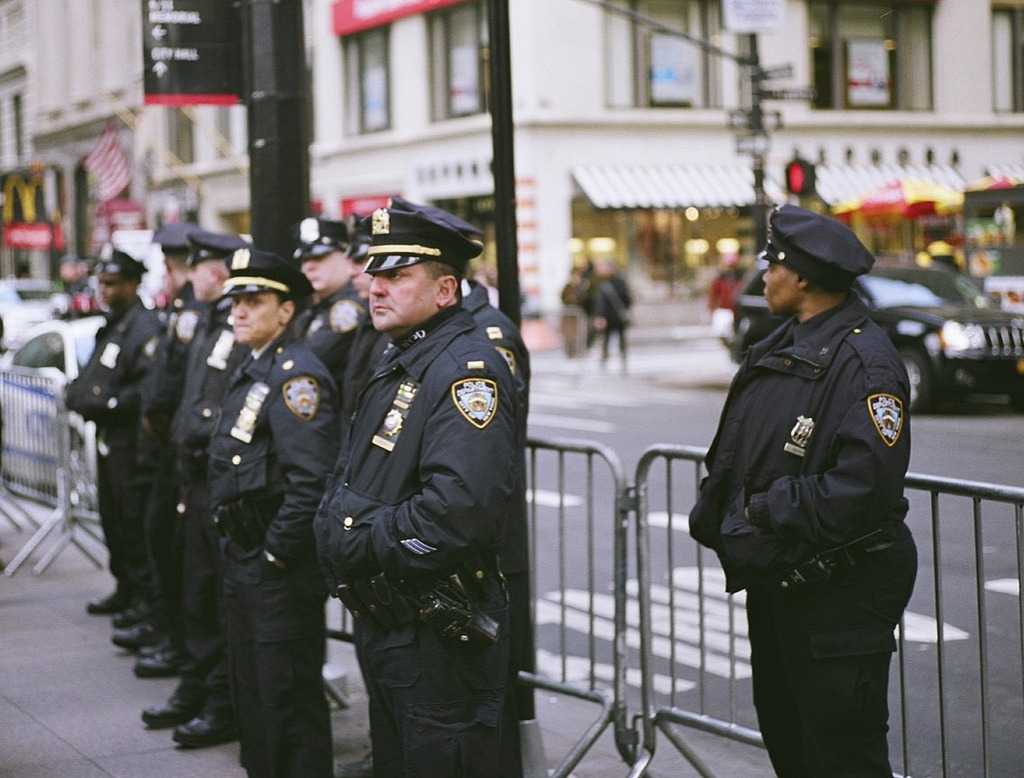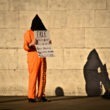Photo Credit: Jamie Kenny
A police state of nightmares may look like a phalanx of gas-masked officers marching down the street. But a more accurate image of today’s existing police state looks like multiplying numbers of beat cops standing on a corner. Police forces have increasingly “saturated” cities across the country by taking on the jobs of overextended public health workers without straying from their basic mission: the protection of valuable property.
“Saturation” is the term used by Ruth Wilson Gilmore and Craig Gilmore in their chapter of the book Policing the Planet, a new anthology of essays, reportage, and interviews on the global state of urban policing published by Verso in May. For the Gilmores, saturation describes a strategy of contemporary policing overlooked by mainstream accountability campaigns such as Campaign Zero and President Obama’s Task Force on 21st Century Policing. The cops, they contend, will always find ways to further embed themselves into our social fabric so as to make themselves seem indispensable—using calls for “community policing,” for instance, to bolster their ranks. This is exactly what happened in New York City last year, when the City Council successfully pushed for hiring 1,297 new officers to increase neighborhood outreach. The Gilmores trace how a growing Los Angeles Police Department saturated the city under the guise of “community policing” in the 1970s, while at the same time amassing heavy-duty weaponry, importing counterinsurgency tactics from the military, and apprehending ever larger numbers of poor, primarily non-white people.
Policing the Planet had been in the works since Spring of 2014, according to its editors, Jordan Camp and Christina Heatherton, but the project took on a new sense of urgency after the Black Lives Matter movement coalesced later that year. The relationship between policing and rising property values in gentrifying cities across the world is the central focus of the book, which features contributions from a wide range of scholars, journalists, and activists. Through compiling so many critical voices in one place, Camp and Heatherton have created a much-needed guidebook of resistance to our planet’s police state and the structures of urban governance that feed it. They jointly responded to a series of questions in an interview conducted by e-mail.
Cantú: Your book makes connections between policing in different cities across the world, looking not only at big players like New York and Los Angeles, but also at paramilitary drug crackdowns in Puerto Rico, the organizing of the Albuquerque-based, Marxist Native American group Red Nation, and of course, the uprisings in Ferguson and Baltimore. What’s the common policing thread running through these places, and what does it tell us about the fundamental role of police in our society?
Camp and Heatherton: In speaking to scholars, activists, artists, and journalists, we found one thread tying together struggles across the planet: broken windows policing. The metaphor of “broken windows” comes from a 1982 Atlantic article, which proposed that a broken window in a neighborhood signaled neglect and encouraged small crimes, which subsequently led to larger ones. This so-called “theory” has encouraged police to address small signs of disorder (such as graffiti, litter, panhandling, etc.) in an effort to prevent larger crimes. In practice, broken windows has constituted a fundamental expansion and redefinition of policing at the urban scale. While this theory has been thoroughly debunked by social scientists, the broken windows metaphor still endures as a kind of common sense in policing and policy.
We see struggles against broken windows policing in campaigns against stop and frisk, protests against gang injunctions in Oakland, CA, lawsuits against poverty taxes like those in Ferguson, fights against the policing of Indigenous lives in Albuquerque, NM, and in mobilizations against the police killings of Eric Garner, Rekia Boyd, Michael Brown, Loreal Tsingine, Alex Nieto, among others. Similarly, protests against the global exportation of “zero tolerance” policies throughout the Americas such as “mano dura” (Iron Fist) in Puerto Rico, or Plan Escoba (the Sweep) in Guatemala, or similar measures in Western Europe, militarized areas of the war on terror, and beyond are all part of the same struggle. Wherever police are used to facilitate gentrification, implement austerity, and naturalize displacement, we see struggles against broken windows. Policing the Planet describes how broken windows policing has emerged as an ideological project: the political expression of neoliberalism at the urban scale.
Cantú: Since the Ferguson uprising, the idea of “community policing” has been in vogue in the media and among politicians as a path to reform. Yet its definition remains vague, and in your book, activist and legal scholar Justin Hansford writes that community policing actually supports “mass incarceration and America’s system of anti-Black state violence.” Can you explain how community policing might actually be more insidious than it sounds, and the different ways it can be used to perpetuate harm in low income communities of color?
Camp and Heatherton: Justin Hansford is a law professor and Ferguson activist who accompanied Mike Brown’s family to the United Nations. He also testified before President Obama’s Task Force on 21st century Policing. In his chapter, Hansford describes how the process of granting police greater access to communities does not make those communities safer. Rather, such intrusion intensifies mass criminalization. Community policing is presented as the milder and friendlier alternative to broken windows policing, when it practice, there is little difference—a point he and contributors like Naomi Murakawa make throughout the book. William Bratton, the key proponent of broken windows and current NYPD Police Commissioner, recently described broken windows policing as “probably the most vivid example of community policing there is.”
Why has “community policing” gained popularity in the current moment? Ruth Wilson Gilmore and Craig Gilmore describe how the concept emerged in response to the urban rebellions in Watts, Detroit, and hundreds of other U.S. cities in the 1960s. Those uprisings forced police departments to update their strategies of social control in order to regain legitimacy. In the wake of the 2014-2015 uprisings in New York, Ferguson, Baltimore, and other U.S. cities, we see the Justice Department promoting “community policing” towards similar ends. Community policing is essentially broken windows policing, rebranded.
Cantú: Across the country, the primary targets of policing continue to be poor people of color, especially in urban spaces where property values are rising. These patterns are routine, but their persistence is especially striking today, a year a half since the most important revolt against racist policing in years began. How can the movement against police violence continue to build on the work that has been done so far?
Camp and Heatherton: Years before he was killed, [Eric] Garner was regularly stopped and harassed for small-scale infractions. In his last minutes, he addressed the approaching officers, saying, “Every time you see me you arrest me. I’m tired of it. It stops today.” In repeating the phrase “it stops today,” activists have not only called attention to the way Garner died, they have challenged the conditions under which he was forced to live. In this respect, they have challenged the ongoing practice of broken windows policing.
The expansion of policing and prisons has facilitated the withdrawal of funding for public education, housing, employment, and healthcare. In turn, social problems have been translated into criminal problems. When your only tool is a hammer, ever problem looks like a nail. This is the common sense of broken windows policing.
Alternatives are bubbling up all around us. We have to learn to listen to the voices that are emerging from social movements confronting racism, militarism, and capital—the policing of the planet. This book is an attempt to assemble these voices and amplify their alternative visions.
Cantú: The chapters in Policing the Planet range from short interviews to dense, academic essays, but I was happy to see that the first piece in the book was a poem by Martín Espada called “How We Could Have Lived or Died This Way.” What roles do you see for artists in the struggle against the police?
Camp and Heatherton: We are honored to open the book with a new poem from Martín Espada, the “Pablo Neruda of North American authors.” “How We Could Have Lived or Died This Way” gives shape to the unspeakable horror and time-collapsing rage evoked by these recent killings. Espada writes, “I see /the next Black man, fleeing as the fugitive slave once fled the slave-catcher,/ shot in the back for a broken tail light. I see the cop handcuff the corpse.”
Espada’s poetic vision not only conjures collective memories of racist state violence, it also offers powerful lessons about resistance. In our interview about the significance of the poetic imagination for social movements, Espada explains, “No change for the good ever happens without being imagined first.” How else can we realize a different future unless we can first imagine it?
Jordan T. Camp, a postdoctoral fellow at Brown University, is the coeditor of Policing the Planet: Why the Policing Crisis Led to Black Lives Matter (Verso, 2016), and author of Incarcerating the Crisis: Freedom Struggles and the Rise of the Neoliberal State (University of California Press, 2016). Christina Heatherton, Assistant Professor at Trinity College, is the coeditor of Policing the Planet, and author of the forthcoming book, The Color Line and the Class Struggle: The Mexican Revolution, Internationalism, and the American Century (University of California Press).
Aaron Cantú is a journalist based in New York City and a contributor to the forthcoming book Who Do You Serve, Who Do You Protect? Police Violence and Resistance in the United States (Haymarket, 2016).




0 Comments